
The bee-eaters are a group of non-passerine birds in the family Meropidae, containing three genera and twenty-seven species. Most species are found in Africa and Asia, with a few in southern Europe, Australia, and New Guinea. They are characterised by richly coloured plumage, slender bodies, and usually elongated central tail feathers. All have long down-turned bills and medium to long wings, which may be pointed or round. Male and female plumages are usually similar.

The European bee-eater is a near passerine bird in the bee-eater family, Meropidae. It breeds in southern Europe and in parts of north Africa and western Asia. It is strongly migratory, wintering in tropical Africa. This species occurs as a spring overshoot north of its range, with occasional breeding in northwest Europe.

The blue-cheeked bee-eater is a near passerine bird in the bee-eater family, Meropidae. The genus name Merops is Ancient Greek for "bee-eater", and persicus is Latin for "Persian".

The Asian green bee-eater, also known as little green bee-eater, and green bee-eater in Sri Lanka. is a near passerine bird in the bee-eater family. It is resident but prone to seasonal movements and is found widely distributed across Asia from coastal southern Iran east through the Indian subcontinent to Vietnam. Populations in Africa and the Arabian Peninsula that were formerly assigned to this species are now considered distinct species. They are mainly insect eaters and they are found in grassland, thin scrub and forest often quite far from water. Several regional plumage variations are known and several subspecies have been named.

The Abyssinian roller, or Senegal roller, is a member of the roller family of birds which breeds across tropical Africa in a belt south of the Sahara, known as the Sahel. It is resident in the southern part of its range, but northern breeding populations are short-distance migrants, moving further south after the wet season.

The olive bee-eater or Madagascar bee-eater is a near passerine bee-eater species in the genus Merops. It is native to the southern half of Africa where it is present in Angola; Botswana; Burundi; Comoros; Democratic Republic of the Congo; Djibouti; Eritrea; Ethiopia; Kenya; Madagascar; Malawi; Mayotte; Mozambique; Namibia; Rwanda; Somalia; South Sudan; Sudan; Tanzania; Uganda; Zambia; Zimbabwe. It is a common species with a wide range so the International Union for Conservation of Nature has rated their conservation status as "least concern".

The northern carmine bee-eater is an African near passerine bird in the bee-eater family, Meropidae. Alternative common names include the carmine bee-eater or the Nubian bee-eater. It is closely related to the southern carmine bee-eater where the throat is carmine.

The Numfor paradise kingfisher, also known as the cobalt paradise kingfisher, is a tree kingfisher endemic to the Indonesian island of Numfor off the northwestern coast of New Guinea. It is a common species, but the forests where it lives are being affected by logging and the IUCN has rated its conservation status as "near-threatened".

The Biak paradise kingfisher is a tree kingfisher that is endemic to the Indonesian island of Biak which is one of a small group of islands located in Cenderawasih Bay near the northern coast of Papua. This bird has a turquoise-blue back with a white belly and tail streamers and a reddish beak. Its natural habitat is forests and the IUCN has assessed its conservation status as being "near-threatened".
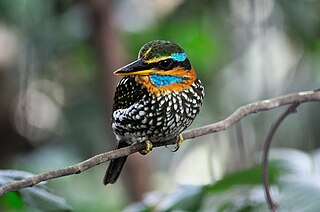
The spotted wood kingfisher or spotted kingfisher is a species of bird in the family Alcedinidae. It is endemic to the Philippines where its natural habitat is subtropical or tropical moist lowland forests.

The racket-tailed roller is a species of bird in the family Coraciidae. It is found in southern Africa from Angola, south-eastern Democratic Republic of Congo and southern Tanzania to northern Botswana, Zimbabwe, Malawi and Mozambique.

The brown-hooded kingfisher is a species of bird in the subfamily Halcyoninae, the tree kingfishers. It has a brown head and blackish and turquoise wings. It is found in Sub-Saharan Africa, living in woodland, scrubland, forest edges, and also suburban areas. The International Union for Conservation of Nature (IUCN) has assessed it as being of least concern.
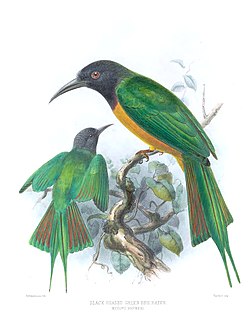
The black-headed bee-eater is a species of bird in the family Meropidae. It is found in forests in tropical Central and West Africa, its range including Angola, Central African Republic, Republic of the Congo, Democratic Republic of the Congo, Ivory Coast, Gabon, Ghana, Nigeria, and South Sudan.

The red-throated bee-eater is a species of bird in the family Meropidae. This species is found in tropical Africa, in Benin, Burkina Faso, Cameroon, Central African Republic, Chad, Democratic Republic of the Congo, Ivory Coast, Ethiopia, Gambia, Ghana, Guinea, Guinea-Bissau, Mali, Mauritania, Niger, Nigeria, Senegal, Sierra Leone, Sudan, Togo, and Uganda. It has a wide range and large total population, and the International Union for Conservation of Nature has assessed its conservation status as being of "least concern".
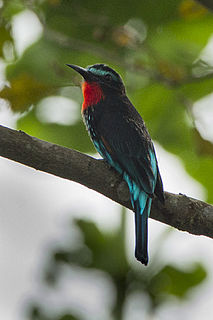
The black bee-eater is a species of bird in the family Meropidae. It is native to the African tropical rainforest where it is found at the edges of the rainforest and in secondary woodland.
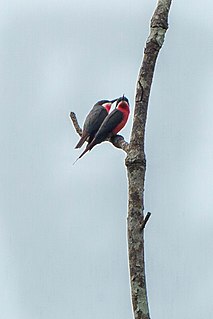
The rosy bee-eater is a species of bird in the family Meropidae. It is found in Angola, Benin, Burkina Faso, Republic of the Congo, Democratic Republic of the Congo, Ivory Coast, Equatorial Guinea, Gabon, Ghana, Nigeria, and Togo.

The cinnamon-chested bee-eater is a species of bird in the family Meropidae. They are found in Burundi, Democratic Republic of the Congo, Ethiopia, Kenya, Rwanda, South Sudan, Tanzania, and Uganda.
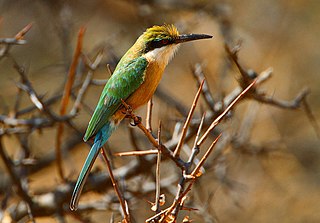
The Somali bee-eater is a species of bird in the family Meropidae. It is found in Ethiopia, Kenya, Saudi Arabia, Somalia and Tanzania. This is a small bee-eater that prefers arid country and desert areas where it may be locally common. The International Union for Conservation of Nature has assessed its conservation status as being of "least concern", postulating that clearing of woodland and forest is creating new suitable habitat for the bird and that its population trend may therefore be rising.

The blue-breasted bee-eater is a central African species of bird. It is a member of the family Meropidae. Meropids are all visually similar and have a diet specialized in Hymenopterans.

Winchell's kingfisher or the rufous-lored kingfisher, is a species of bird in the family Alcedinidae, the kingfishers. It is endemic to the Philippines, its natural habitat being lowland forests. It is threatened by deforestation, and the International Union for Conservation of Nature (IUCN) has assessed it as a vulnerable species.





















